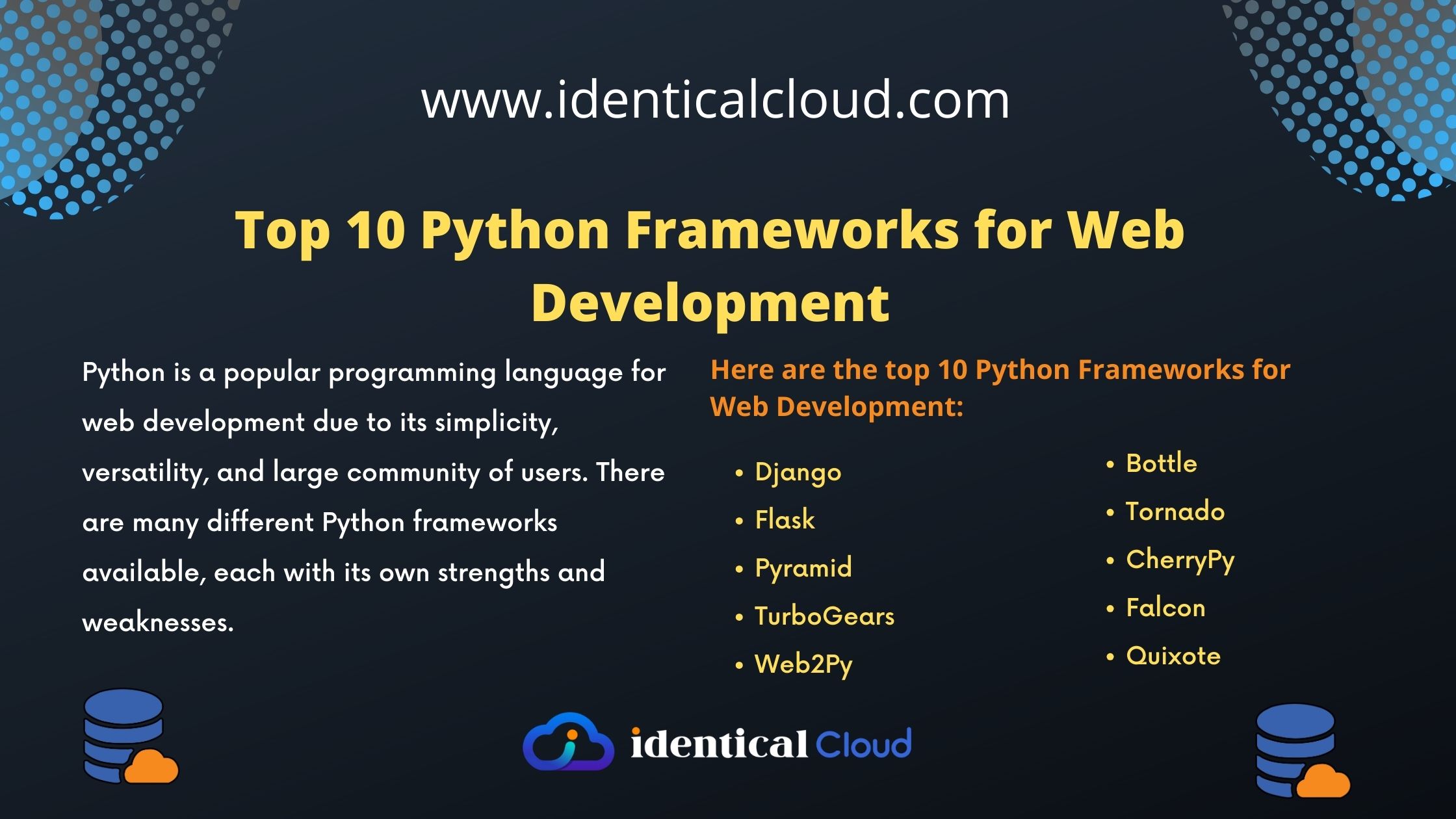
Top 10 Python Frameworks for Web Development
Top 10 Python Frameworks for Web Development
Python is a popular programming language for web development due to its simplicity, versatility, and large community of users. There are many different Python frameworks available, each with its own strengths and weaknesses.
In this blog post, we will discuss the top 10 Python frameworks for web development in 2023. We will consider factors such as popularity, features, ease of use, and community support.
Here are the top 10 Python Frameworks for Web Development:
Django
Django is a full-stack Python framework that is known for its speed, scalability, and security. It is used by many popular websites, such as Instagram, Pinterest, and Spotify.
Key Features of Django:
- Batteries included: Django comes with a wide range of built-in features, such as an object-relational mapper (ORM), a template engine, and an admin interface. This makes it easy to get started with Django and to build complex web applications quickly and easily.
- Secure by design: Django is designed with security in mind. It includes many features to help protect your web application from common attacks, such as cross-site scripting (XSS) and SQL injection.
- Scalable: Django can handle a large amount of traffic and data. It is used by many popular websites that receive millions of visitors per day.
Limitations of Django:
- Learning curve: Django can be difficult to learn for beginners, especially if you are new to Python.
- Performance: Django can be slower than some other Python frameworks, such as Flask and Tornado.
- Flexibility: Django is a full-stack framework, which means that it has its own way of doing things. This can make it difficult to integrate Django with other technologies and frameworks.
Flask
Flask is a microframework for Python that is known for its simplicity, flexibility, and ease of use. It is a good choice for small and medium-sized projects.
Key Features of Flask:
- Lightweight: Flask is a lightweight framework that does not come with a lot of built-in features. This makes it easy to learn and to use, and it also makes it easy to customize the framework to meet your specific needs.
- Flexible: Flask is a very flexible framework. You can choose to use Flask by itself, or you can use it with other frameworks and technologies.
- Easy to learn: Flask is easy to learn, especially if you have experience with Python.
Limitations of Flask:
- Batteries not included: Flask does not come with a lot of built-in features, such as an object-relational mapper (ORM), a template engine, and an admin interface. This can make it more difficult to get started with Flask and to build complex web applications.
- Performance: Flask can be slower than some other Python frameworks, such as Django and Tornado.
- Scalability: Flask is not as scalable as Django or Tornado. It is not suitable for very large web applications that receive millions of visitors per day.
Pyramid
Pyramid is a versatile Python framework that can be used to build a wide range of web applications. It is known for its flexibility and extensibility.
Key Features of Pyramid:
- Flexible: Pyramid is a very flexible framework. You can choose to use Pyramid by itself, or you can use it with other frameworks and technologies.
- Extensible: Pyramid is easily extensible. You can add your own custom components to the framework to meet your specific needs.
- Powerful: Pyramid is a powerful framework that can be used to build complex web applications.
Limitations of Pyramid:
- Learning curve: Pyramid can be difficult to learn, especially for beginners.
- Community support: Pyramid has a smaller community than Django or Flask. This can make it more difficult to find help and support when you need it.
- Performance: Pyramid can be slower than some other Python frameworks, such as Django and Tornado.
TurboGears
TurboGears is a full-stack Python web development framework that is known for its flexibility, scalability, and ease of use. It is built on top of other popular Python frameworks, such as Pyramid and SQLAlchemy.
Key Features of TurboGears:
- Full-stack: TurboGears provides everything you need to build a web application, from the database to the user interface.
- Flexible: TurboGears is a very flexible framework. You can choose to use TurboGears by itself, or you can use it with other frameworks and technologies.
- Scalable: TurboGears is a scalable framework that can handle a large amount of traffic and data.
- Easy to use: TurboGears is easy to use, especially if you have experience with other Python frameworks, such as Pyramid and SQLAlchemy.
Limitations of TurboGears:
- Learning curve: TurboGears can be difficult to learn, especially for beginners.
- Community support: TurboGears has a smaller community than Django or Flask. This can make it more difficult to find help and support when you need it.
- Performance: TurboGears can be slower than some other Python frameworks, such as Django and Tornado.
Web2Py
Web2Py is a full-stack Python web development framework that is known for its simplicity, ease of use, and portability. It is a good choice for beginners and intermediate developers who want to build web applications quickly and easily.
Key Features of Web2Py:
- All-in-one: Web2Py comes with everything you need to build a web application, including a database, a template engine, and a web server.
- Easy to use: Web2Py is easy to use, even for beginners. It has a web-based development environment that makes it easy to create, edit, and deploy web applications.
- Portable: Web2Py can be run on a variety of operating systems and web servers. This makes it a good choice for developing web applications that need to be deployed on multiple platforms.
Limitations of Web2Py:
- Performance: Web2Py can be slower than some other Python frameworks, such as Django and Flask.
- Scalability: Web2Py is not as scalable as Django or Flask. It is not suitable for very large web applications that receive millions of visitors per day.
- Community support: Web2Py has a smaller community than Django or Flask. This can make it more difficult to find help and support when you need it.
Bottle
Bottle is a lightweight Python web development microframework that is known for its simplicity, speed, and flexibility. It is a good choice for small and medium-sized projects, as well as for developing REST APIs.
Key Features of Bottle:
- Lightweight: Bottle is a very lightweight framework, with a core library of just a few thousand lines of code. This makes it easy to learn and use, and it also makes it easy to customize the framework to meet your specific needs.
- Fast: Bottle is a fast framework, thanks to its minimalist design and efficient codebase.
- Flexible: Bottle is a very flexible framework. You can choose to use Bottle by itself, or you can use it with other frameworks and technologies.
Limitations of Bottle:
- Batteries not included: Bottle does not come with a lot of built-in features, such as an object-relational mapper (ORM), a template engine, and an admin interface. This can make it more difficult to get started with Bottle and to build complex web applications.
- Community support: Bottle has a smaller community than Django or Flask. This can make it more difficult to find help and support when you need it.
- Documentation: Bottle has less documentation than some other Python frameworks. This can make it more difficult to learn and use the framework.
Tornado
Tornado is a high-performance Python web framework that is known for its speed, scalability, and concurrency. It is well-suited for real-time applications, such as chat applications, online games, and streaming applications.
Key Features of Tornado:
- High performance: Tornado is a very high-performance framework, thanks to its asynchronous design and efficient codebase.
- Scalable: Tornado is highly scalable, and can handle a large number of concurrent connections.
- Concurrent: Tornado is designed for concurrency, and makes it easy to develop real-time applications.
Limitations of Tornado:
- Learning curve: Tornado can be difficult to learn, especially for beginners.
- Community support: Tornado has a smaller community than Django or Flask. This can make it more difficult to find help and support when you need it.
- Batteries not included: Tornado does not come with a lot of built-in features, such as an object-relational mapper (ORM), a template engine, and an admin interface. This can make it more difficult to get started with Tornado and to build complex web applications.
CherryPy
CherryPy is a lightweight, object-oriented Python web framework that is known for its simplicity, flexibility, and performance. It is a good choice for a variety of web applications, including small and medium-sized projects, REST APIs, and microservices.
Key Features of CherryPy:
- Simple: CherryPy is a very simple framework to learn and use. It has a clean and concise API, and it does not require any external dependencies.
- Flexible: CherryPy is a very flexible framework. You can use it to build a variety of web applications, from simple websites to complex web services.
- Performant: CherryPy is a very performant framework. It is able to handle a large number of concurrent requests with low overhead.
Limitations of CherryPy:
- Community support: CherryPy has a smaller community than Django or Flask. This can make it more difficult to find help and support when you need it.
- Documentation: CherryPy’s documentation is not as comprehensive as some other Python frameworks. This can make it more difficult to learn and use the framework.
- Batteries not included: CherryPy does not come with a lot of built-in features, such as an object-relational mapper (ORM), a template engine, and an admin interface. This can make it more difficult to get started with CherryPy and to build complex web applications.
Falcon
Falcon is a blazing fast, minimalist Python web API framework for building robust app backends and microservices. It is known for its ease of use, performance, and reliability.
Key Features of Falcon:
- Fast: Falcon is one of the fastest Python web frameworks available. It is designed to handle a high volume of requests with low latency.
- Lightweight: Falcon is a very lightweight framework, with a core library of just a few thousand lines of code. This makes it easy to learn and use, and it also makes it easy to customize the framework to meet your specific needs.
- Easy to use: Falcon has a simple and intuitive API. It is easy to learn and use, even for beginners.
- Reliable: Falcon is a very reliable framework. It is well-tested and has a proven track record in production use.
Limitations of Falcon:
- Community support: Falcon has a smaller community than Django or Flask. This can make it more difficult to find help and support when you need it.
- Documentation: Falcon’s documentation is not as comprehensive as some other Python frameworks. This can make it more difficult to learn and use the framework.
- Batteries not included: Falcon does not come with a lot of built-in features, such as an object-relational mapper (ORM), a template engine, and an admin interface. This can make it more difficult to get started with Falcon and to build complex web applications.
Quixote
Quixote is a full-stack Python web framework that is known for its flexibility and scalability. It is based on the Zope toolkit, and it provides a number of features that make it easy to develop complex web applications.
Key Features of Quixote:
- Flexible: Quixote is a very flexible framework. It can be used to build a wide range of web applications, from simple websites to complex web services.
- Scalable: Quixote is highly scalable. It can handle a large number of concurrent users and requests.
- Secure: Quixote is designed to be secure. It includes a number of features to help protect your web application from common attacks.
- Extensible: Quixote is easily extensible. You can add your own custom components to the framework to meet your specific needs.
Limitations of Quixote:
- Learning curve: Quixote can be difficult to learn, especially for beginners.
- Community support: Quixote has a smaller community than Django or Flask. This can make it more difficult to find help and support when you need it.
- Performance: Quixote is not as performant as some other Python frameworks, such as Django or Flask.
We hope this blog post has helped you learn more about the top 10 Python frameworks for web development. When choosing a framework for your next project, be sure to consider your specific needs and requirements.
FAQ’s
What is a Python framework?
A Python framework is a collection of Python libraries and tools that provide a standard way to build web applications. Frameworks provide a number of features that make it easier and faster to develop web applications, such as routing, templating, and database access.
What are the benefits of using a Python framework?
There are many benefits to using a Python framework:
– Increased productivity: Frameworks can help you develop web applications more quickly and easily by providing a number of pre-built features and functionality.
– Improved code quality: Frameworks can help you write better code by enforcing best practices and providing a standard way to structure your code.
– Reduced security risks: Frameworks can help you develop more secure web applications by providing features such as built-in authentication and authorization.
– Increased scalability: Frameworks can help you develop web applications that can scale to handle large amounts of traffic.
Which Python framework is right for me?
The best Python framework for you will depend on your specific needs and requirements. Some of the factors to consider include:
– Your experience level: Some frameworks are easier to learn and use than others.
– The type of web application you are building: Some frameworks are better suited for certain types of web applications, such as REST APIs or microservices.
– The features you need: Different frameworks offer different features. Make sure to choose a framework that has the features you need for your project.








